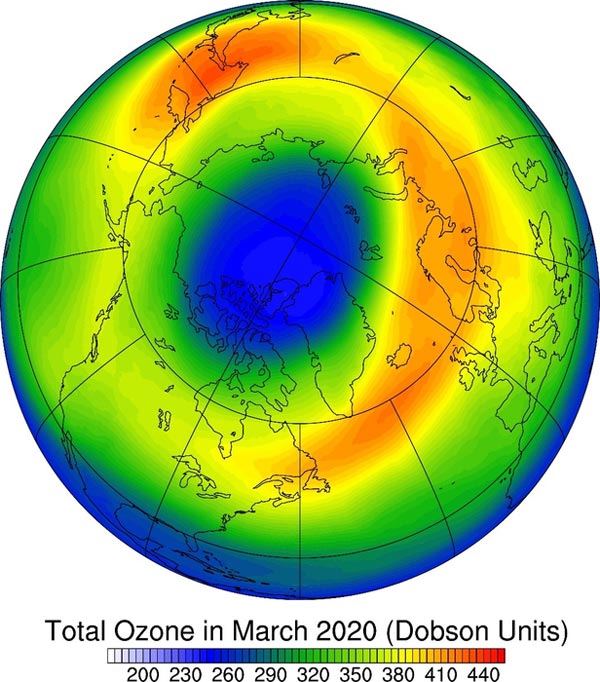Spring 2020 arctic “ozone hole” likely caused by record-high north pacific sea surface temperatures

Arctic “ozone hole” during March 2020.
Credit: Yan Xia
Unlike the Antarctic ozone hole that develops annually during austral spring (September, October, and November), Arctic ozone levels usually stay well above the ozone hole threshold. The Arctic stratospheric vortex is typically too warm for polar stratospheric clouds to form, which are a key ingredient in severe ozone depletion processes. Much stronger planetary wave activity occurs in the Northern Hemisphere than in the Southern Hemisphere, which generates stronger dynamical heating to warm the stratospheric Arctic vortex. Despite this, polar meteorologists reported a record-breaking Arctic “ozone hole” during spring 2020, prompting a research inquiry into what caused this unusual phenomenon.
Scientists from the Department of Atmospheric and Oceanic Sciences, School of Physics at Peking University, led by Prof. Yongyun Hu, found that that the Arctic “ozone hole” in spring 2020 was likely caused by record-high North Pacific sea surface temperatures (SST). They published their full analysis in Advances of Atmospheric Sciences.
Using real observed data, results show that a weakened “wavenumber-1 wave” is responsible for the anomalously cold Arctic stratospheric vortex. This weakening of planetary wave is associated with record high SST during late winter and early boreal spring.
“The record-high North Pacific sea surface temperatures during February and March 2020 led to a large reduction of wavenumber-1 wave activity by modifying the Aleutian low.” Prof. Hu explained. “The reduction of planetary wave activity caused the extremely cold and persistent stratospheric polar vortex between February and April 2020 which provided the necessary conditions for severe ozone loss.”
To reach this conclusion, Dr. Hu and his team designed several sensitivity experiments using a long-range climate model. Performing multiple experiments and iterations were necessary to provide a comprehensive picture of the effects that record-breaking North Pacific sea surface temperatures had on the Arctic stratospheric vortex.
“The formation of the record Arctic ozone loss in spring 2020 indicates that present-day ozone depleting substances are still sufficient to cause severe springtime ozone depletion in the Arctic stratosphere.” said Prof. Hu. “These results suggest that severe ozone loss is likely to occur in the near future as long as North Pacific warm SST anomalies or other dynamical processes are sufficiently strong.”
Journal: Advances in Atmospheric Sciences
DOI: 10.1007/s00376-021-0359-9
Article Title: Record Arctic Ozone Loss in Spring 2020 is Likely Caused by North Pacific Warm Sea Surface Temperature Anomalies
Article Publication Date: 10-Jul-2021
Media Contact
Zheng Lin
Institute of Atmospheric Physics, Chinese Academy of Sciences
jennylin@mail.iap.ac.cn
Office: 01-082-995-053
All latest news from the category: Earth Sciences
Earth Sciences (also referred to as Geosciences), which deals with basic issues surrounding our planet, plays a vital role in the area of energy and raw materials supply.
Earth Sciences comprises subjects such as geology, geography, geological informatics, paleontology, mineralogy, petrography, crystallography, geophysics, geodesy, glaciology, cartography, photogrammetry, meteorology and seismology, early-warning systems, earthquake research and polar research.
Newest articles

Innovative 3D printed scaffolds offer new hope for bone healing
Researchers at the Institute for Bioengineering of Catalonia have developed novel 3D printed PLA-CaP scaffolds that promote blood vessel formation, ensuring better healing and regeneration of bone tissue. Bone is…

The surprising role of gut infection in Alzheimer’s disease
ASU- and Banner Alzheimer’s Institute-led study implicates link between a common virus and the disease, which travels from the gut to the brain and may be a target for antiviral…

Molecular gardening: New enzymes discovered for protein modification pruning
How deubiquitinases USP53 and USP54 cleave long polyubiquitin chains and how the former is linked to liver disease in children. Deubiquitinases (DUBs) are enzymes used by cells to trim protein…



